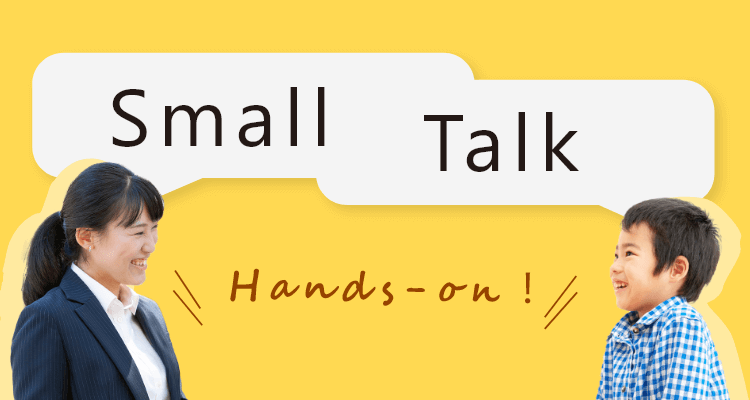小・中#2-2: What do you do first thing in the morning? 朝、何をしますか?(後)
Small Talkってどうしたらいいの?
児童生徒の発話を引き出す問いかけって?
ここでは、今日の授業ですぐに使える実践例を毎週トピックとともにご紹介します。
小学校5、6年生から中学校はじめまでに学習する表現を使った児童(生徒)とのやり取りの例です。
前回は「朝起きてからすること」をトピックに、まず指導者が「児童に使わせたい表現」を用いて自分のことを語り、その後「朝起きていちばん最初にすること」、あるいは「朝起きて最初にする3つのこと」に向けて対話を展開させる例を紹介しました。
小・中#2-1: What do you do first thing in the morning? 朝、何をしますか?(前)
特に「一日の生活」について、「すること」の「順番」を意識して話すために必要な表現(例えば first, second, then, finally など)は、取り出して知識として「教え込む」よりも、先生自身の発話や、児童の発話を受けてのフィードバックのなかに何度も組み込み、児童に「こんなふうに言うといいんだな」と気付かせることを大切にしました。実際に「使いながら学ぶ」体験を、「ことばの学び」では意識して取り入れたいものです。
今回も同様に「一日の生活」を表す語句や表現に慣れ親しんだ児童と、「家に帰ってからすること」と「寝る前にすること」というトピックから、対話を展開させていきます。そして、Small Talk という言語活動のなかで、先生が意識したい指導のポイントについて考えます。
【展開例3】最初は児童一人一人に尋ね、次第にクラス全体への問いかけに発展させる
まず先生が「(学校や外出から)家に帰って最初にすること」というトピックを提示し、自分が帰宅して最初に「着替えをする」ことを伝えます。さらに児童が答える時にヒントになるよう、その次に「手を洗う」ことにも触れます。
S1とS3が「帰宅したら最初に手を洗う」と同様に答えるのを受けて、今度はクラス全体に質問を投げ掛け、調査することにします。先生がほかの児童に尋ねている時には、自分の答えを考えずに聞いている児童がいるかもしれません。
このようにクラスの児童全員に反応を求めることで、「一人一人に考えさせる」ことができます。また先生も、調査により答えの違う児童が分かるため、同じ答えの繰り返しで単調なやり取りになるのを避けることができます。
T: What is the first thing you do when you get home? I usually change my clothes. [I usually change into more comfortable clothes.] Then, I wash my hands and prepare for dinner.
How about you? When you get home, what do you usually do first, S1?
S1: Wash hands ….
T: You wash your hands. All right. Then, what do you do next? [What’s next?]
S1: Study.
T: You study! Study … what?
S1: 宿題 ….
T: Oh, 宿題! How do you say 宿題 in English, everyone? Can you help S1? ①
S2: Homework.
T: That’s right. Good. Homework. Everyone, repeat after me, “homework,” … “homework,” … “I do my homework.” … “I do my homework.” ②
〈児童は先生の後について発音する〉
T: Now, S1, what do you do after you wash your hands [after washing your hands]?
S1: I do my homework.
T: Well done! I see. You do your homework after washing your hands. Thank you, S1.T: Hi, S3. What do you do first when you get home?
S3: I wash my hands.
T: You wash your hands first? It’s the same as S1. OK. Everyone, … “I wash my hands first,” … Raise your hand! ③
〈該当する児童は挙手する〉
T: One, two, three, … twelve! So, S4, you didn’t raise your hand. What is the first thing you do when you get home?
S4: ….(続く)
指導のポイント〈上記展開例中の①~③に対応〉
① 児童が日本語を使って答えたときには、先生がそれを英語で文の形にして聞かせます。ただし、それがすでに何度も聞いたり言ったりして慣れ親しんだ単語の場合は How do you say ~ in English?「~は英語で何と言いますか」とクラス全体に尋ねて引き出すこともできます。
②「宿題」は英語でhomeworkだと引き出す際、S1のほかにも習得していない児童がいる可能性もあることから、クラス全体で発音して耳に残るようにします。
最初は homework という単語のみ、そして I do my homework. という文の形で2回ずつ繰り返します。これは homework という単語に初めて出合ったときに I do my homework. という文で親しんだこと、そしてS1に今度は自分で「(家に帰ったら)宿題をする」と英語で答えて自信を付けてもらいたいことが理由です。特にS1は直前に「Study」と言いかけていますので、study homework* とつながらないようにするねらいもあります。
ちなみに発音練習をする時に2回繰り返すことには、1回目に十分モデルを聞き取れていない可能性があることと、自分が言った後にモデルをもう一度聞いて確認し、それを再度言ってみることで習得を促す目的があります。
③ 特に小学校の場合、複雑な疑問文はもちろん意味が分かりづらいので、簡潔な問いかけをすることが必要です。ここでは「『自分はまず手を洗うよ』(という人)、手を挙げて!」という形で尋ねています。

【展開例4】既習表現を引き出しながら話を発展させる
例えば「夜寝る前にすること」というトピックについて、より多くの児童に答えさせるやり取りとは異なり、一人一人の児童との「対話を深める」やり取りがあります。以下はその例です。
What do you do before going to bed?(寝る前に何をしますか)という問いかけに対して、S1 が「テレビ(を観る)」と答えました。そこに既習の「時間を尋ねる」表現を使って What time do you usually go to bed?(ふつう何時に寝ますか)と続けます。その後も「好きかどうかを尋ねる」表現 Do you like cartoons? や「好きなものを尋ねる」 What is your favorite cartoon?、さらに「理由を尋ねる」 Why を用いた問いかけを組み込んで、S1からより詳細な情報を引き出していきます。
T: I usually read books before I go to bed. I can relax and sleep well. What do you do before you go to bed, S1?
S1: テレビ ….
T: You watch TV before you go to bed. What time do you usually go to bed?
S1: Nine.
T: I see. What TV programs do you watch?
S1: アニメ
T: You watch anime, cartoons, on TV? Do you like cartoons?
S1: Yes.
T: I like cartoons very much, too. What is your favorite cartoon? What kind of cartoons do you like? ④
S1: I like XXX.
T: Oh, me too. It’s exciting. Why do you like XXX?
S1: YYY … かっこいい
T: I agree. YYY is very cool. Thank you, S1. Do you like cartoons, S2?
S2: Yes. I like XXX.
T: You also like XXX. It’s very popular. OK., S2, what do you usually do before going to bed? ⑤
S2: Brush teeth …
T: You brush your teeth. That’s very important!
指導のポイント
④ 前出の cartoons を受ける代名詞 them を用いる方が自然なところですが、児童が初めて触れた語であることから、意図的に cartoons を繰り返し、何度も聞かせることで音から慣れ親しませようとしています。
⑤ 児童は I go to bed. という文の形で「寝る」ことを表す表現に出合っています。そのため、before go ing to bed の動名詞に慣れ親しんでいない段階では before I [you] go to bed という形を多く使いながら、次第に going も取り入れていくようにするとよいでしょう。

このように先生から児童への問いかけやフィードバックで用いられる表現には、 児童が既習の語句や表現にどの程度慣れ親しんでいるか に応じて、さまざまな 意図的な「調整」 が行われるものです。こう言うと、英語を教えることに対して構えてしまう先生もいらっしゃるかもしれませんが、難しく考える必要はありません。
基本はまず、児童が 最初に触れた表現 をそのまま先生が繰り返して言い、児童にも使わせること。小学校や中学校のはじめでは、構文の複雑さよりも、 児童生徒がこれまで学んだ表現をフル活用して、どこまで自分が伝えたいことを表現できるかを体験すること が大切です。
そして 「どうしても伝えたいことが英語で言えなかった」と感じたときが、新しい語句や表現を学ぶとき 。Small Talk はこの「どこまで自分の考えや気持ちを英語で伝えられるか」を試すときでもあるのです。



